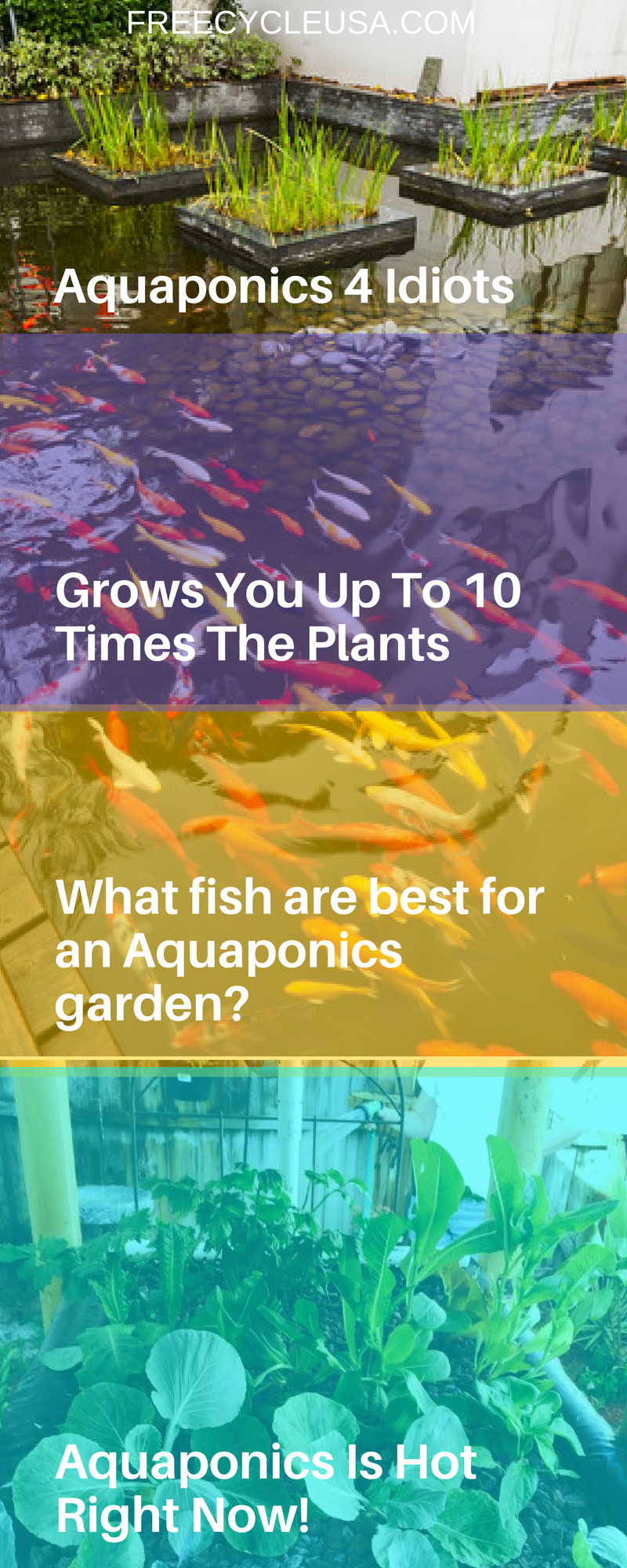Aquaponics 4 Idiots – The Idiot Proof Way of Building an Aquaponic System
Aquaponics is a combination of the aquaculture (growing fish) and hydroponics(growing soilless plants) system that mutually benefits both environments. Aquaponics does not use any chemicals and requires only 1/10 of the water that would be needed to grow plants in the garden or field. It also only needs a fraction of the water that is used for fish culture (aquaculture).
The waste produced in the fish tanks is treated by natural bacteria that converts the waste, largely ammonia, first into nitrite and then into nitrate. The fish waste absorbed by plants is pumped to a biofilter system as a nutrient solution for growing the plants (grow bed). The only external input to the system is food for the fish. Both systems complement each other as a single unit, not as separate units.
Once the system is established the water stays pH balanced and remains crystal clear. The water is recycled with a small amount of water added weekly to compensate for what is lost by the evaporation.
What are the benefits of an Aquaponics system?
An Aquaponics system can produce vegetables and fish for family consumption all the year round.
Removes the backbreaking task of digging in a typical vegetable garden.
There is no weeding necessary.
No need for extra chemical nutrients or fertilizers necessarily in a normal garden.
Reduces the use of pesticides in the garden.
Reduction in the amount of water needed — generally only needed to top up due to evaporation.
Eliminates waste products having to be discarded as these are used to fertilize the plants.
What plants will grow in an Aquaponics system?
There are many plants that are suitable for any Aquaponics system including vegetables and salad etc.
The major group that cannot be grown are root vegetables.
A good guide is to find out which above ground plants grow in your particular area of the country, then it is worth trying them in your Aquaponics system.
In general, it has been found that plants in an Aquaponics system, with the nutrients from the fish, grow much faster than plants in a traditional garden.
The most common plants grown in an Aquaponics system are herbs and Green leafy vegetables and salad. other plants such as tomatoes, cucumber, chilies, peas, etc can also be grown. Herbs like Basil, parsley, watercress, sage, etc are ideal for the Aquaponics system.
It is always worth trying any of your favorite plants and you could be pleasantly surprised by the results.
What fish are best for an Aquaponics garden?
Tilapia is one of the most common fish to be used in an Aquaponics garden, but there are many other types depending on whether you want them to be for food or just to provide nutrients for the growing vegetables. Such fish as silver perch, trout, catfish, goldfish, Bass, Bream, etc will all provide nutrients for the Aquaponics garden.
What fish food do I need?
The type of fish food will greatly depend on the type of fish you are using in your Aquaponics garden.
It is always recommended that you find out all you can about the particular type of fish by either going on Google or purchasing a book about them. The type and quantity of food will also depend on the amount of output you would expect from the Aquaponics garden.
What factors determine a successful Aquaponics garden?
The first and main factor in having a successful Aquaponics garden is to ensure that the fish are maintained in a healthy state. All fish need oxygen to survive and flourish and therefore a good aeration system is essential.
The temperature of the water is also quite critical for fish to survive. Any abnormal rise or fall in temperature can cause problems for the fish. It should be checked to see what temperature is optimum for the type of fish you have.
The PH of the water should be between 7 to 7.5 which is neither acid or alkaline. If the PH rises or falls then it is essential that the cause should be quickly rectified. This could be that the fish are being overfed and the uneaten fish food is decomposing and collecting at the bottom of the fish tank.
Both macronutrients and micronutrients are essential for the plants to grow in an Aquaponics garden. Most of these nutrients come from fish waste, which is a result of the fish eating the fish food.
Plants need these nutrients to grow and if there is any shortage of nutrients then there is a possibility that the plants will not taste as good or grow as fast.
Testing the water at regular intervals will ensure that you will correct any problems long before they have had any chance to do any real damage. It can tell you if you are feeding the fish too much if there is sufficient oxygen in the water if it is at the right temperature etc.
What water can be used in the Aquaponics garden?
Although both freshwater and saltwater can be used in the Aquaponics garden, the most common is freshwater. Using saltwater would limit the number of different plants you can grow.
If you use tap water it should be checked for chlorine content and this removed before adding fish. The clearer the water the easier it will be to keep a watchful eye on the fish and any build up of any sediment at the bottom of the fish tank.
Does the Aquaponics garden need to be situated indoors?
An Aquaponics garden can be set up indoors or outdoors in the backyard.
If it is set up either in a greenhouse, garage or even in the house, you will have the added advantage in that it will be protected from the weather. If it is set up outdoors then it will have to cope with rain, snow and even hot sunshine which can make it uncomfortable for the fish and development of the plants.
Having it indoors could make it more expensive, with added lighting and heating, etc. but giving you a much more control atmosphere.
Can the Aquaponics garden be run as a hobby?
The best thing about Aquaponics gardening is that it can be adapted to any size you want from a backyard system to a small indoor fish tank where you already have a few goldfish.
Aquaponics gardening has the advantage of being an ideal hobby for either children, people who go out to work or retired. You can make it take up as much of your time as you want and develop it to what time and energy you want to spend on it.
It is one of the most creative hobbies for children in that it teaches them about looking after fish and how food is produced.
How much work is involved in running an Aquaponics garden?
Once the Aquaponics garden is set up there is very little that needs to be done to keep it running in a viable state.
The first job is to feed the fish, this needs to be done at least once a day.
Checking that the aeration system is working correctly. This rarely needs any attention and as long as a good stream of bubbles is rising to the surface, it should be ok.
Planting your seeds or bulbs and checking that they are growing.
Harvesting produces when it is ready.
Testing the water at regular intervals to ensure that the PH is satisfactory.
Topping up the water as necessary
To find out more about Backyard Aquaponics and how to make a profit from your own Aquaponics system click on the link below.
Aquaponics Is Hot Right Now! Building your own DIY Aquaponics System has never been easier. Learn How To Grow Vegetables 1000% Faster In Half The Time with this incredible course. ~the Hottest Gardening Offer Available.






